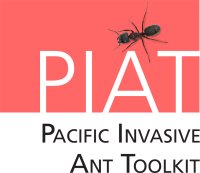National Invasive Ant Survey case study
New Zealand’s National Invasive Ant Surveillance (NIAS) programme’s objective is to detect new infestations of invasive ant species in high risk sites such as ports, airports, devanning sites and transitional facilities.
The programme was established in 2003 following an incursion of red imported fire ant (Solenopsis invicta) in Auckland. Annual surveys have run ever since.
Detection of new infestations
High risk sites are identified by annual pathway and site risk analyses by the Ministry for Primary Industries (MPI). Typically, these sites are at airports, seaports, devanning centres and holding facilities where in-bound cargo arrives or is stored.
Unloading and moving of newly arrived cargo disturbs any hitchhiking ant colonies and they rapidly move to any suitable habitats within the high risk site. Fortunately, the habitats available to ants in these high risk areas tend to be of low quality and poorly resourced (e.g. little food), which inhibits colony growth and promotes constant foraging activity.
Potential habitats in high risk areas such as shrubs, poles, gaps between paving stones, grassy knolls, drains, plant pots, piles of rubbish etc. are designated as “risk sites”. These risk sites are targeted by the NIAS, as they represent the best opportunity for detection of newly arrived invasive ant species.
Survey activities
Risk sites are visually surveyed in mid-summer to early autumn by teams coordinated by AsureQuality Ltd.
Attractive lure “pottles” (60ml plastic vials with their screw on caps removed) containing carbohydrate (30% sugar solution on a cotton ball) or protein (peanut butter in soya oil mixed with raw sausage meat) are placed alternately in a 10 x 10m grid in the risk sites. GPS data is recorded on portable data loggers for each pottle placed.
Ants are normally detected when the outside temperature is between 20 and 28°C. Lures are left out for two hours between 20 and 24.9°C and one hour between 25 and 28°C. The pottles are collected and recapped with any ants found on the lures sealed inside.
As many as 48,000 pottles may be deployed across New Zealand in a single year. Each individual pottle is given a barcode that corresponds to its exact collection point. All samples are tracked from the field collection through to identification by an electronic barcoding system.
Collection processing
Once collected, the pottles are sent for identification to Flybusters Antiants Consulting Ltd diagnostics division. All ants colected are identified and recorded. Any suspected exotic specimens (i.e. those not already present in New Zealand or any threat species) are forwarded to the MPI Information and Diagnostic Centre for confirmation.
If an exotic species is positively identified, the collection site is revisited using the GPS data and the source nest is either located or destroyed or a baiting programme is initiated. This management action is followed by regular monitoring to ensure the eradication has been successful.
Information Sources
Craddock, Mattson. 2014. National invasive ant surveillance programme report 2014. Report by the New Zealand Ministry of Primary Industries
Peacock, Mattson, Craddock Pettigrew. 2015. National invasive ant surveillance programme annual report 2015. Report by the New Zealand Ministry of Primary Industries
